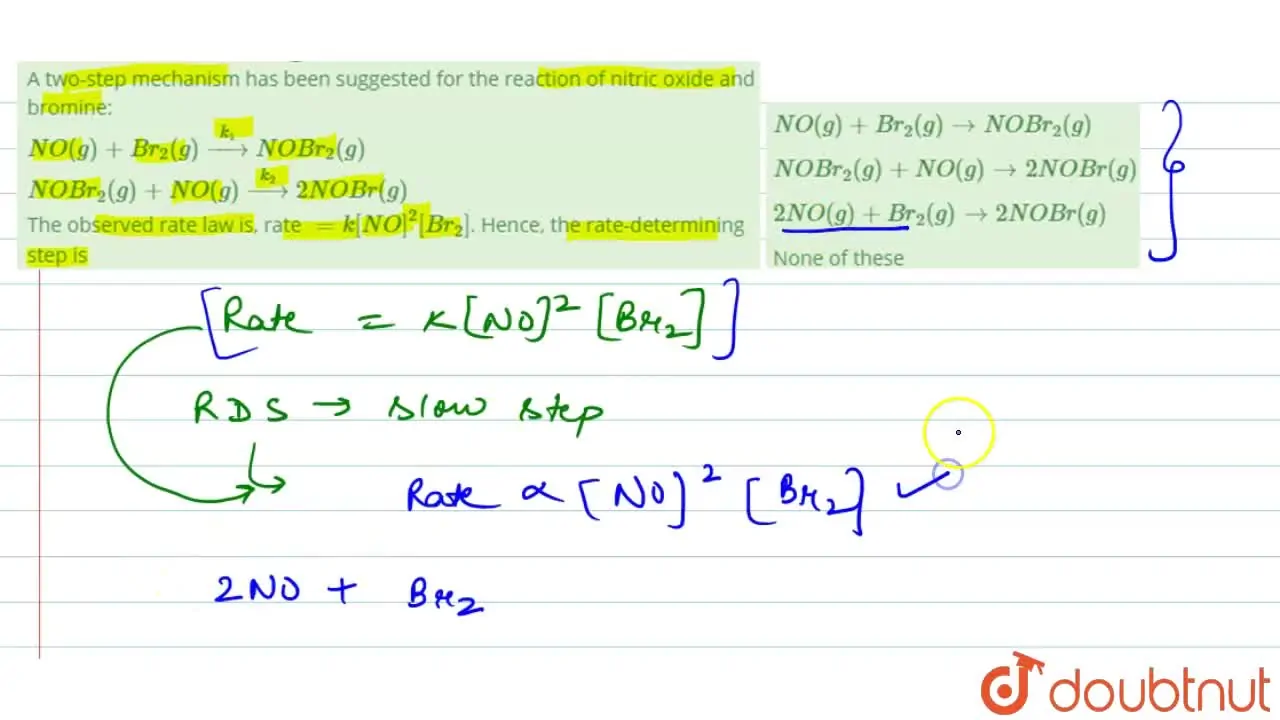The rate constant for the decompoistion of a certain reaction is described by the equation:
logk(s−1)=14−1.25×104KT
A two-step mechanism has been suggested for the reaction of nitric oxide and bromine:
NO(g)+Br2(g)k1−−→NOBr2(g)
NOBr2(g)+NO(g)k2−−→2NOBr(g)
The observed rate law is, rate =k[NO]2[Br2]. Hence, the rate-determining step is
NO(g)+Br2(g)→NOBr2(g)
NOBr2(g)+NO(g)→2NOBr(g)
2NO(g)+Br2(g)→2NOBr(g)
None of these
The correct Answer is:B
NO(g)+Br2(g)k1⇐⇒NOBr2(g) …(i)
NOBr2(g)+NO(g)k2−−→RDA2NOBr(g) …(ii)
∴Rate=k2[NOBr2][NO] …(iii)
Since NOBr2 is the reactive intermediate, so its concentration is determined form step (i).
∴k1orkeq=[NOBr2][NO][Br2]
or [NOBr2]=k1[NO][Br2]
Substitute the [NOBr2] in step (iii),
∴Rate=k1k2[NO]2[Br2]=K[NO]2[Br2]
Related Playlists
- BOOK - CENGAGE CHEMISTRY ENGLISHCHAPTER - CHEMICAL KINETICSEXERCISE - Exercises Multiple Correct33videos
CHEMICAL KINETICS
- BOOK - CENGAGE CHEMISTRY ENGLISHCHAPTER - CHEMICAL KINETICSEXERCISE - Exercises Single Correct177videos
CHEMICAL KINETICS
- BOOK - CENGAGE CHEMISTRY ENGLISHCHAPTER - CHEMICAL KINETICSEXERCISE - Ex4.4 Objective10videos
CHEMICAL KINETICS
- BOOK - CENGAGE CHEMISTRY ENGLISHCHAPTER - CARBOXYLIC ACIDS AND THEIR DERIVATIVESEXERCISE - Exercises Archives (Analytical And Descriptive)34videos
CARBOXYLIC ACIDS AND THEIR DERIVATIVES
- BOOK - CENGAGE CHEMISTRY ENGLISHCHAPTER - COORDINATION COMPOUNDSEXERCISE - Archives Subjective18videos
COORDINATION COMPOUNDS
Similar Questions
The rate constant for the decompoistion of a certain reaction is described by the equation:
logk(s−1)=14−1.25×104KT
Energy of activation (in kcal) isView SolutionThe rate constant for the decompoistion of a certain reaction is described by the equation:
logk(s−1)=14−1.25×104KT
Pre-exponential factor for this reaction isView SolutionThe rate constant for the decompoistion of a certain reaction is described by the equation:
logk(s−1)=14−1.25×104KT
At what temperature, rate constant is equal to pre-exponential factor?View SolutionThe rate constant for the decompoistion of a certain reaction is described by the equation:
logk(s−1)=14−1.25×104KT
What is the effect on the rate of reaction at 127∘C, if in the presence of catalyst, energy of activation is lowered by 10kJmol−1?View SolutionThe mechanism of the reaction
2NO+O2→2NO2 is
NO+NOk1⇐⇒k−1N2O2(fast)
N2O2+O2k2−−→2NO2(slow)
The rate constant of the reaction isView SolutionEquilibrium constants K1 and K2 for the following equilibria
NO(g)+1/2O2(g)K1⇐⇒NO2(g) and
2NO2(g)K2⇐⇒2NO(g)+O2(g)
are related asView SolutionThe following mechanism has been proposed for the reaction of NO with Br2 to from NOBr.
NO(g)+Br2⇔NOBr2(g)
NOBr2(g)+NO(g)→2NOBr(g)
If the second step is the rate determining step, the order of the reaction with respect to NO(g) isView SolutionFor the reaction
2H2(g)+2NO(g)→N2(g)+2H2O(g)
the observed rate expression is, rate =kf[NO]2[H2]. The rate experssion for the reverse reaction is :View SolutionThe reaction 2NO+Br2→2NOBr, obeys the following mechanism:
NO+Br2fast⇐⇒NOBr2,NOBr2+NOSlow−−→2NOBr The rate expression of the above reaction can be written asView SolutionConsider the following equilibrium:
SO2(g)+12O2(g)K1⇐⇒SO3(g),
2SO3(g)K2⇐⇒ 2SO2(g)+O2(g)
What is the relation between K1 and K2?View Solution


